Puerto Rico's Monetary History
From the time of Puerto Rico was discovered in 1493, to 1899, when the US exchanged the Puerto Rican "peso" to the dollar, the coins of many countries circulated freely in the island. During the colonization of Puerto Rico, the money that was used in Puerto Rico, was that of Spain. Beginning in the 17th century, the provincial currency (silver) minted in the Casa de Moneda de Madrid, in the denominations of 1 peso, 40 cents, 20 cents, 10 cents and 5 cents. These five denominations had a common design, with the figure of Alfonso XIII (1886 - 1931) boy by a side and the other the shield of Spain, with the real crown between the two columns of Hercules and the Puerto Rico inscription.
Coins
5 Centavos de Peso
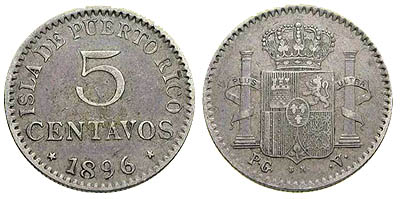
Units: 600.000 coins were minted in its first year of production, 1895 Puerto
Rico PG V
Material: Silver 835/1000
Weight: 1,25gr
Diameter: 16,5mm
Estimated Value $100-$125
10 Centavos de Peso
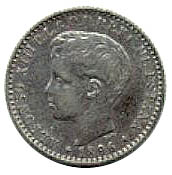
Units: 700,000 coins were minted in its first year of production, 1895 Puerto
Rico PG V
Material: Silver 835/1000
Weight: 2,5gr
Diameter: 18,5mm
Estimated Value $100-150
20 Centavos de Peso
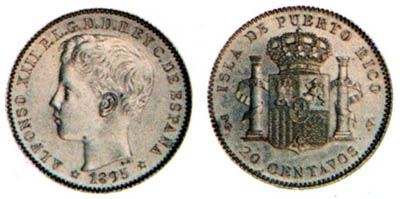
Units: 3.350.006 coins were minted in its first year of production, 1895 Puerto
Rico PG V
Material Silver 835/1000
Weight: 5gr
Diameter: 23,5mm
40 Centavos de Peso
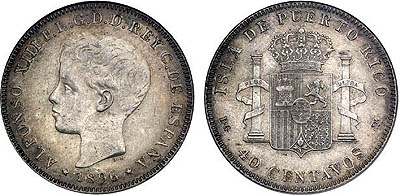
Units: 752.002 coins were minted in its first year of production, 1895 Puerto
Rico PG V
Material: Silver 835/1000
Weight: 10gr
Diameter: 31mm
Estimated Value $300-400
1 Peso
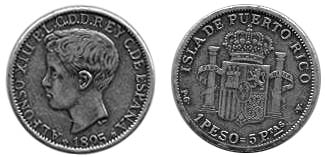
Units: 8.500.021 coins were minted in its first year of production, 1895 Puerto
Rico PG V
Material: Silver 900/1000
Weight: 25 gr
Diameter: 37,5mm

Spanish and American currencies of 1898
Interesting Fact:
The one of Spain it was worth 5 pesetas and the American 1 dollar. From 1895-96 the Puerto Rican provincial peso was in circulation, but at the beginning of the 20th century an interchange took place, paying 60 cents of a dollar, which created a serious problem to investors, banks and the economy in general. The Puerto Rican currency had more value, in silver, that the one from the USA, but this one was endorsed in gold and the Puerto Rican only by its own weight in silver. In the end the Puerto Rican peso was fused to make the dollar of 1902.
Notes/Bills
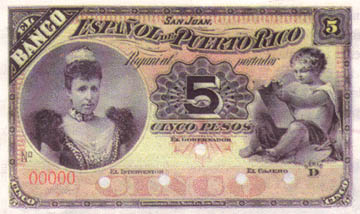
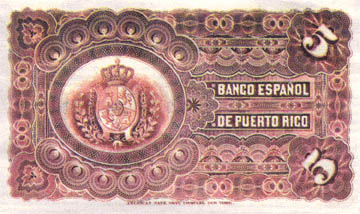
The Puerto Rican 5 pesos, series D, of the Spanish
Bank of Puerto Rico. The bank was founded on 1888, of private capital and it
had license from the Spanish government to issue notes during 25 years
(1888-1913). After the Spanish-American War the bank was renamed
Bank of Puerto Rico. The front shows the head of Queen Maria Cristina.
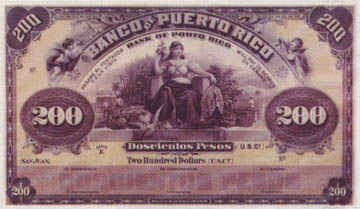
The Puerto Rican bilingual note of 200 pesos or dollars. This note
was issued by the Bank of Puerto Rico (Bank of Porto Rico)
just a short time after the cession of the Island.
The Treaty of Paris forced the United States to respect all licenses
or effective concessions, reason why the Bank of Puerto Rico, old
Spanish Bank of Puerto Rico, continued this operation
until its liquidation in 1913. In the beginning, the Bank of Puerto
Rico reprinted Spanish bills with red ink with the phrase
"American currency". The reprinted Spanish bills were those that
had the Paschal Lamb, instead of Queen Maria Cristina.
Interesting Fact
After one hundred years of use of the United States monetary system,
Puerto Ricans still refer to the dollar, as the "peso";
to "quarter" (25 cents), as "peseta";
to "nickel" (5 cents), as "vellon" or "ficha" and
to the cent, as "chavo" or "perrita".
Glossary
mint: a place where coins, medals, or tokens are made
Sources
- De la Peseta al Euro: Camino Hacia la Unión
- Isla de Puerto Rico - 5 Centavos Peso, 1896
- Moneda y Numismatica en Puerto Rico
- Monedas de Alfonso XIII
- Puerto Rico 1890-1898



